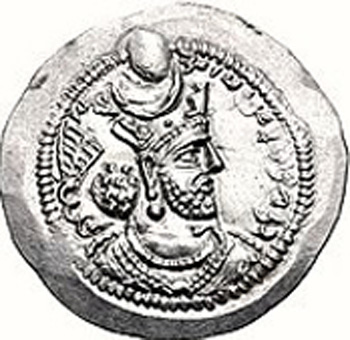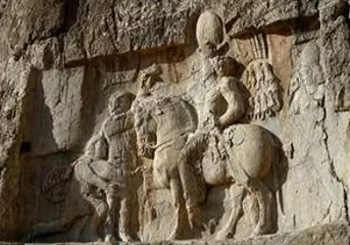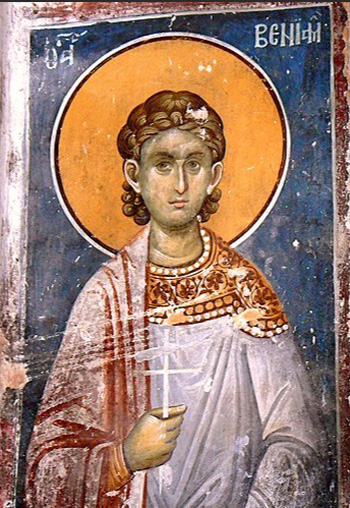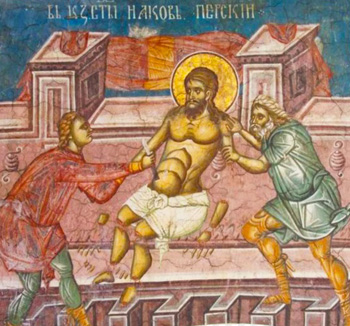Saints of the Day
 |
 |
 |
 |
 |
 |
 |
Ss. Hormizd, Maharsapor, Sahin,
Benjamin & Jacob - August 8
Biographical selection:
Bahram V, King of Persia in the 5th century, was a cruel persecutor of Christians. Five martyrs of his time became particularly famous: Hormizd, Maharsapor, Sahin (Suenes), Benjamin and Jacob.
Hormizd was from the Aquemanides family in the highest rank of the Persian nobility. Called before the King he was ordered to renounce Christ, which he strongly refused to do. The Sovereign despoiled him of all his honors and goods and obliged him to wear a rough loincloth and to take care of the camels of the Royal Force.
 After a long time passed, Bahram saw Hormizd from a window of the palace and noticed his skin was burned brown by the sun and covered with dust. The King was somewhat moved, recalling what Hormizd had been and his high ancestry.
After a long time passed, Bahram saw Hormizd from a window of the palace and noticed his skin was burned brown by the sun and covered with dust. The King was somewhat moved, recalling what Hormizd had been and his high ancestry.
He called Hormizd, gave him a beautiful linen tunic, and said: "Leave off your stubbornness and renounce the Son of the carpenter." Hormizd tore off the tunic and threw it at the King: "If you judged that with this gift you would induce me to abandon my Religion, then keep it - along with your impiety." From there he was taken to face new challenges and then martyrdom.
Maharsapor (also commemorated on October 10, November 2 or November 27 depending on the Catholic Rite) was a Persian Prince of illustrious birth and great virtue. For being a Catholic he suffered tortures and was condemned to three years in prison. After that time, since he still would not deny Christ, he was thrown in a filthy pit without water or food. Days later he was found there dead, his body in kneeling position and surrounded by light.
Sahin (Suenes) was a lord of many slaves. Because he refused to deny Christ, the King inquired who was the most vicious slave of Sahin. Then, as punishment for his refusal, the King gave Sahin, his wife and all his slaves to that bad slave.
Benjamin, a deacon, was imprisoned for a year for speaking courageously for Christ. He was then offered his liberty under the condition that he not preach the Catholic Doctrine. Benjamin declared it was his duty to preach and that he could not bury a talent of which he had to give an account to God. He died after suffering terrible tortures.
Jacob was of an illustrious family. He had been a Christian and abandoned the Faith. But his wife and mother brought him back to the True Religion. King Bahram ordered that all the members of his body be sawed to pieces at their joints. Finally, only his trunk remained, and since he continued to confess Jesus Christ, he was beheaded.
Comments of Dr. Plinio:
We do not know which of these different martyrdoms to admire the most. You see that we are in the presence of persons of high social dignity who had much to lose in this life, and yet they willingly gave it all up. They abandoned everything with pride and panache, moved by their love for Our Lord Jesus Christ.
In the case of St. Hormizd, we see the high rank he had and to what a low level he was prostrated. He, who was the first in the court, was reduced to be a slave and obliged to care for camels and lead them through the desert. After a long time the King called him to appear again before him and gave him gifts; then, he asked him to deny Our Lord.
Hormizd could have found a way to compromise a little in order to not fall a second time into the wrath of the King. But, he absolutely did not. When he saw the King's intention was to make him apostatize, he took a manly attitude and walked boldly toward his death: He took the apparel the King had offered him and threw it in his face.
You see how this reaction is different from the modern mindset. An individual with a modern mentality who would be condemned to pass his life pulling camels through the desert would react quite differently.
As he approached the palace to see the King, his heart is filled with nostalgia for the time he had freely entered the court wearing precious garments corresponding to his high rank. "O dear palace where I ate, drank and was courted by everyone. where I had a great familiarity with the King." Long sobs… Then, romantic pity: "Will no one have pity on me? Poor me!" A man with the modern mentality has self-pity, which is the start of every madness.
Suddenly, our modern man receives an invitation from the King. Then, he begins to think: "If I could at least become a garbage man in the court rather than be the care-taker of camels in the desert… Later I might even receive a promotion and see some of my old goods restored."
 The modern man arrives at the chamber of the King's room thinking that the King has good intentions: "I think that he wants to free me; what a good King!" By the time he arrives before the King, he has already half-surrendered to
him.
The modern man arrives at the chamber of the King's room thinking that the King has good intentions: "I think that he wants to free me; what a good King!" By the time he arrives before the King, he has already half-surrendered to
him.
Where is the courage to take all the King's gifts and throw them in his face? Even more, where is the courage to face martyrdom? This man with a modern mindset lacks the virility and the will to renounce the goods of this world; he does not have the detachment needed to face martyrdom.
On the contrary, St. Hormizd did not have the will to abandon his destiny, the will to gain some earthly goods for himself. So, when the King attacked his Faith, he counter-attacked the King with a magnificent grandness.
Afterwards, he was killed, but he knew this would happen and he did not care. This is to have panache, it is to have elegance, it is to walk toward death by one's own initiative for a high cause. For the cause of causes, which is the cause of Our Lord Jesus Christ.
Then, let us look at St. Maharsapor, who was found dead in a noxious pit – killed by the stench and by hunger and thirst – dead, but still kneeling and surrounded by light. Imagine the beautiful scene of a noble Catholic who ends his life in a kind of sewer expelling a horrible stench, but kneeling and surrounded by a luminosity that spotlights him.
By the splendor that irradiated from him, contrasting starkly with the noxious atmosphere of the pit the purity of that integral soul, his dedication and his communication with God became more admirable. God made this miracle to illustrate Maharsapor's grandness.
St. Sahin (Suenes) had a destiny similar to that of St. Hormizd. He was the lord of many slaves and ended by becoming the slave of his worst slave. The selection does not say that he was killed. Perhaps he still lived a long life in this miserable condition. In that case he had a special form of martyrdom, which is to have a long life engulfed in misfortune and great sufferings, a fate worse than death.
For one to live as the slave of a man who was his worst slave is something terrible, especially in those times. This is what he had to bear, nonetheless he persevered to the end.
 But I believe that of these martyrdoms, the most admirable was that of St. Benjamin. He was a Deacon and was offered his liberty under the condition that he not preach Catholic doctrine. He was not asked to abjure the Faith; he was just asked to be quiet, to no longer speak.
But I believe that of these martyrdoms, the most admirable was that of St. Benjamin. He was a Deacon and was offered his liberty under the condition that he not preach Catholic doctrine. He was not asked to abjure the Faith; he was just asked to be quiet, to no longer speak.
Do you know many persons who would take the position of St. Benjamin? I do not. I know many who would say: "Well, if the King forbids me to preach and make an apostolate, I will comply. I can become a weaver, I will plant potatoes, I will do anything but I will continue to live. Since the King threatens me with death, I am dispensed from preaching and evangelizing."
However, this is not what Benjamin did. You see to what degree he took his duties as a Deacon. He preferred to face death rather than to conform to such a condition. It is a truly magnificent thing!
Finally we have the case of St. Jacob, whose members were sawed from his body until he had only his trunk. Can you imagine the pain and the psychological suffering of such a torture? First he had an arm sawed off; a pool of blood forms as the executioner tosses it aside.
Then, the second arm… When it comes to the last leg, what is the condition of that man? All types of hemorrhages, his organisms reacting in violent and unknown ways, his heart beat accelerating, the blood in his head pulsing from pressure, malaises of every kind, his life blood fading… but he continued to proclaim God. Finally, they beheaded him.
 It is something particularly difficult for human nature to have the same torment repeated, one time after another. The fact that St. Jacob saw his second arm, then, his two legs sawed from his trunk is one torment multiplied by another. Well, he faced all them and he remained faithful to the end.
It is something particularly difficult for human nature to have the same torment repeated, one time after another. The fact that St. Jacob saw his second arm, then, his two legs sawed from his trunk is one torment multiplied by another. Well, he faced all them and he remained faithful to the end.
These are examples of perseverance that show us the love these men had for Our Lord Jesus Christ, Our Lady and the Holy Catholic Church. For them to prefer to suffer all these torments rather than to abandon the Catholic Church shows a superlative love for her.
We should imagine them in the apex of their suffering affirming: "I believe in the Holy Catholic, Apostolic and Roman Church; I believe in Jesus Christ Savior of mankind, I believe in the One Trine God."
And the martyrdom continues… slaps, guffaws, new blows. To apostatize or to not apostatize… You can imagine what this struggle was! How enormous the force of love and union of those men with Our Lord was!
What a grace it would be for us to see the gaze of those martyrs and, through their gazes, admire and receive a little of their virtue, a little of their fortitude, a little of their state of soul. How much we would give for this opportunity!
Thus do we commemorate the most beautiful martyrdoms of these Persian Saints.

The Saint of the Day features highlights from the lives of saints based on comments made by the late Prof. Plinio Corrêa de Oliveira. Following the example of St. John Bosco who used to make similar talks for the boys of his College, each evening it was Prof. Plinio’s custom to make a short commentary on the lives of the next day’s saint in a meeting for youth in order to encourage them in the practice of virtue and love for the Catholic Church. TIA thought that its readers could profit from these valuable commentaries.
The texts of both the biographical data and the comments come from personal notes taken by Atila S. Guimarães from 1964 to 1995. Given the fact that the source is a personal notebook, it is possible that at times the biographic notes transcribed here will not rigorously follow the original text read by Prof. Plinio. The commentaries have also been adapted and translated for TIA’s site.
Bahram V, King of Persia in the 5th century, was a cruel persecutor of Christians. Five martyrs of his time became particularly famous: Hormizd, Maharsapor, Sahin (Suenes), Benjamin and Jacob.
Hormizd was from the Aquemanides family in the highest rank of the Persian nobility. Called before the King he was ordered to renounce Christ, which he strongly refused to do. The Sovereign despoiled him of all his honors and goods and obliged him to wear a rough loincloth and to take care of the camels of the Royal Force.

King Bahram V of Persia, 5th century
He called Hormizd, gave him a beautiful linen tunic, and said: "Leave off your stubbornness and renounce the Son of the carpenter." Hormizd tore off the tunic and threw it at the King: "If you judged that with this gift you would induce me to abandon my Religion, then keep it - along with your impiety." From there he was taken to face new challenges and then martyrdom.
Maharsapor (also commemorated on October 10, November 2 or November 27 depending on the Catholic Rite) was a Persian Prince of illustrious birth and great virtue. For being a Catholic he suffered tortures and was condemned to three years in prison. After that time, since he still would not deny Christ, he was thrown in a filthy pit without water or food. Days later he was found there dead, his body in kneeling position and surrounded by light.
Sahin (Suenes) was a lord of many slaves. Because he refused to deny Christ, the King inquired who was the most vicious slave of Sahin. Then, as punishment for his refusal, the King gave Sahin, his wife and all his slaves to that bad slave.
Benjamin, a deacon, was imprisoned for a year for speaking courageously for Christ. He was then offered his liberty under the condition that he not preach the Catholic Doctrine. Benjamin declared it was his duty to preach and that he could not bury a talent of which he had to give an account to God. He died after suffering terrible tortures.
Jacob was of an illustrious family. He had been a Christian and abandoned the Faith. But his wife and mother brought him back to the True Religion. King Bahram ordered that all the members of his body be sawed to pieces at their joints. Finally, only his trunk remained, and since he continued to confess Jesus Christ, he was beheaded.
Comments of Dr. Plinio:
We do not know which of these different martyrdoms to admire the most. You see that we are in the presence of persons of high social dignity who had much to lose in this life, and yet they willingly gave it all up. They abandoned everything with pride and panache, moved by their love for Our Lord Jesus Christ.
In the case of St. Hormizd, we see the high rank he had and to what a low level he was prostrated. He, who was the first in the court, was reduced to be a slave and obliged to care for camels and lead them through the desert. After a long time the King called him to appear again before him and gave him gifts; then, he asked him to deny Our Lord.
Hormizd could have found a way to compromise a little in order to not fall a second time into the wrath of the King. But, he absolutely did not. When he saw the King's intention was to make him apostatize, he took a manly attitude and walked boldly toward his death: He took the apparel the King had offered him and threw it in his face.
You see how this reaction is different from the modern mindset. An individual with a modern mentality who would be condemned to pass his life pulling camels through the desert would react quite differently.
As he approached the palace to see the King, his heart is filled with nostalgia for the time he had freely entered the court wearing precious garments corresponding to his high rank. "O dear palace where I ate, drank and was courted by everyone. where I had a great familiarity with the King." Long sobs… Then, romantic pity: "Will no one have pity on me? Poor me!" A man with the modern mentality has self-pity, which is the start of every madness.
Suddenly, our modern man receives an invitation from the King. Then, he begins to think: "If I could at least become a garbage man in the court rather than be the care-taker of camels in the desert… Later I might even receive a promotion and see some of my old goods restored."

A bas relief of a Persian Prince of that time
Where is the courage to take all the King's gifts and throw them in his face? Even more, where is the courage to face martyrdom? This man with a modern mindset lacks the virility and the will to renounce the goods of this world; he does not have the detachment needed to face martyrdom.
On the contrary, St. Hormizd did not have the will to abandon his destiny, the will to gain some earthly goods for himself. So, when the King attacked his Faith, he counter-attacked the King with a magnificent grandness.
Afterwards, he was killed, but he knew this would happen and he did not care. This is to have panache, it is to have elegance, it is to walk toward death by one's own initiative for a high cause. For the cause of causes, which is the cause of Our Lord Jesus Christ.
Then, let us look at St. Maharsapor, who was found dead in a noxious pit – killed by the stench and by hunger and thirst – dead, but still kneeling and surrounded by light. Imagine the beautiful scene of a noble Catholic who ends his life in a kind of sewer expelling a horrible stench, but kneeling and surrounded by a luminosity that spotlights him.
By the splendor that irradiated from him, contrasting starkly with the noxious atmosphere of the pit the purity of that integral soul, his dedication and his communication with God became more admirable. God made this miracle to illustrate Maharsapor's grandness.
St. Sahin (Suenes) had a destiny similar to that of St. Hormizd. He was the lord of many slaves and ended by becoming the slave of his worst slave. The selection does not say that he was killed. Perhaps he still lived a long life in this miserable condition. In that case he had a special form of martyrdom, which is to have a long life engulfed in misfortune and great sufferings, a fate worse than death.
For one to live as the slave of a man who was his worst slave is something terrible, especially in those times. This is what he had to bear, nonetheless he persevered to the end.

St. Benjamin the Deacon was martyred because he refused to stop his apostolate
Do you know many persons who would take the position of St. Benjamin? I do not. I know many who would say: "Well, if the King forbids me to preach and make an apostolate, I will comply. I can become a weaver, I will plant potatoes, I will do anything but I will continue to live. Since the King threatens me with death, I am dispensed from preaching and evangelizing."
However, this is not what Benjamin did. You see to what degree he took his duties as a Deacon. He preferred to face death rather than to conform to such a condition. It is a truly magnificent thing!
Finally we have the case of St. Jacob, whose members were sawed from his body until he had only his trunk. Can you imagine the pain and the psychological suffering of such a torture? First he had an arm sawed off; a pool of blood forms as the executioner tosses it aside.
Then, the second arm… When it comes to the last leg, what is the condition of that man? All types of hemorrhages, his organisms reacting in violent and unknown ways, his heart beat accelerating, the blood in his head pulsing from pressure, malaises of every kind, his life blood fading… but he continued to proclaim God. Finally, they beheaded him.

St. James or Jacob had all his members cut off
before being beheaded
These are examples of perseverance that show us the love these men had for Our Lord Jesus Christ, Our Lady and the Holy Catholic Church. For them to prefer to suffer all these torments rather than to abandon the Catholic Church shows a superlative love for her.
We should imagine them in the apex of their suffering affirming: "I believe in the Holy Catholic, Apostolic and Roman Church; I believe in Jesus Christ Savior of mankind, I believe in the One Trine God."
And the martyrdom continues… slaps, guffaws, new blows. To apostatize or to not apostatize… You can imagine what this struggle was! How enormous the force of love and union of those men with Our Lord was!
What a grace it would be for us to see the gaze of those martyrs and, through their gazes, admire and receive a little of their virtue, a little of their fortitude, a little of their state of soul. How much we would give for this opportunity!
Thus do we commemorate the most beautiful martyrdoms of these Persian Saints.
 | |
|
|
The texts of both the biographical data and the comments come from personal notes taken by Atila S. Guimarães from 1964 to 1995. Given the fact that the source is a personal notebook, it is possible that at times the biographic notes transcribed here will not rigorously follow the original text read by Prof. Plinio. The commentaries have also been adapted and translated for TIA’s site.